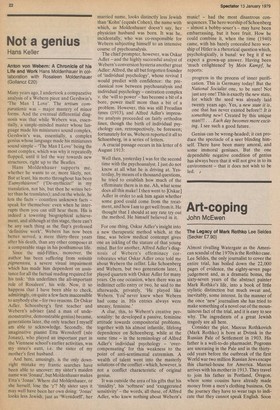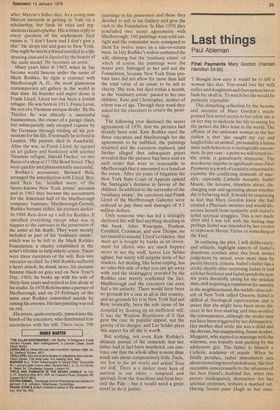Art-coping
John McEwen
The Legacy of Mark Rothko Lee Seldes (Secker £7.90) Almost rivalling Watergate as the American scandal of the 1970s is the Rothko case. Lee Seldes, the only journalist to cover the entire trial, has boiled down the 22,000 pages of evidence, the eighty-seven page judgement and, as a dramatic bonus, the sixty-seven years of the abstract painter Mark Rothko's life, into a book of little stylistic distinction but much sweat and, inevitably, some interest. In the manner of the once 'new' journalism she has tried to make something of a novel out of the mountainous fact of the trial, and it is easy to see why. The ingredients of a great Jewish tragedy are all here.
Consider the plot. Marcus Rothkovich (Mark Rothko) is born at Dvinsk in the Russian Pale of Settlement in 1903. His father is a well-to-do pharmacist. Pogroms are unceasing in the Pale and in the thirtyodd years before the outbreak of the first World war two million Russian Jews escape this charnel-house for America. Marcus arrives with his mother in 1913. They travel to join his father in Portland, Oregon, where some cousins have already made money from a men's clothing business. On the journey they have to wear tags to indicate that they cannot speak English. Soon after, Marcus's father dies. As a young man Marcus succeeds in getting to Yale on a scholarship, but finds its rules and regulations claustrophobic. His written reply to every question of his sophomore final exams is, 'I don't know and I don't give a shit.' He drops out and goes to New York. One night he meets a friend enrolled in a life 'drawing class and is dazzled by the beauty of the nude model. He becomes an artist.
Many years later in 1963, when he has become world famous under the name of Mark Rothko, he signs a contract with Marlborough A. G., the most glamorous contemporary art gallery in the world at that time. Its founder and major domo is Frank Lloyd. Lloyd too has been a Jewish refugee. He was born in 1911, Franz Levai, the son of a Viennese antique dealer. By the Thirties he was already a successful businessman, the owner of a garage chain, but subsequently only escaped capture by the Germans through trading all his possessions for his life. Eventually he arrived in London. His parents died in Auschwitz. After the war, as Frank Lloyd, he opened an art gallery and bookstore with another Viennese refugee, Harold Fischer, on two floors of a shop at 17 Old Bond Street. They were quickly and phenomenally successful.
Rothko's accountant, Bernard Reis, arranged the introduction with Lloyd. Bernard Reis Inc. handled many of the better-known New York artists' accounts and in 1963 they became the accountants for the American half of the Marlborough company business, Marlborough-Gerson. Rothko became richer, his pictures darker. In 1968 Reis drew up a will for Rothko. It specified everything except what was to happen to the canvases in the possession of the artist at his death. They were merely included as part of his 'residuary estate', which was to be left to the Mark Rothko Foundation, a charity established in the artist's lifetime to help elderly artists. There were three executors of the will. Reis was executor-in-chief. In 1968 Rothko suffered a heart attack, he drank more, his pictures became black on gray and on New Year's Day, 1969, he broke up with his wife of thirty-four years and retired to live alone at his studio. In 1970 Reis became a partner of Marlborough, and on 25 February of the same year Rothko committed suicide by cutting his arteries. His last painting was red on red.
His estate, quite correctly, passed into the hands of the executors, who distributed it in accordance with his will. There were 798 paintings in his possession and these they decided to sell to his Gallery and give the cash to the Foundation. In May 1970 they concluded two secret agreements with Marlborough: 100 paintings were sold outright and the remainder were consigned to them for twelve years on a sale-or-return basis. In July Rothko's widow contested the will, claiming that the 'residuary estate', of which of course the paintings were the major part, belonged to her and not the Foundation, because New York State probate laws did not allow for more than half the total value of an estate to be left to charity. She won,.but died within a month, so the 'residuary estate' passed to her two children, Kate and Christopher, neither of whom was of age. Through their ward they asked for the executors to return the paintings.
The following year disclosed the secret agreements of 1970, that the pictures had already been sold. Kate Rothko sued the three executors and Marlborough for the agreements to be nullified, the paintings returned and the executors replaced, and further alleged that subsequent prices revealed that the pictures had been sold on such terms that were so reasonable to Marlborough that it amounted to a fraud on the estate. After six years of litigation the New York State Court of Appeals upheld the Surrogate's decision in favour of the children. In addition to the surrender of the 'residuary estate', the executors and Frank Lloyd of the Marlborough Galleries were ordered to pay fines and damages of 9.3 million dollars.
Only someone who has led a strangely sheltered life will find anything shocking in this book. After Watergate, Poulson, Cornfeld, Crossman, and now Thorpe, we are inured to scandal. Lloyd's evidence, that most art is bought by banks as an investment for clients who are much happier never to see the stuff, leaves Lee Seldes aghast, but surely will surprise none of her readers. Art dealing, like horse-coping, has no rules this side of what you can get away with, and the skulduggery revealed by the Rothko case merely confirmed the fact. Marlborough and the executors can even feel a bit unlucky. There would have been no grounds for a case at all in this country, and no grounds for it in New York had not Reis, ironically, been the sole cause of his downfall by drawing up an inefficient will. It was the Winslow Boyishness of it that gave the case its popular appeal, not the gravity of its charges, and Lee Seldes plays this aspect for all she is worth.
But nothing, not even Kate Rothko's ultimate pursuit of the innuendo that her father had in fact been murdered, can convince one that the whole affair is more than much ado about comparatively little. Facts, are few in the art world and artists lives are dull. There is a darker story here of survival in our times — temporal and spiritual, from the Anschluss and from beyond the Pale — but it would need a great novel to do it justice.



































 Previous page
Previous page